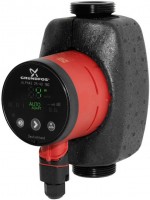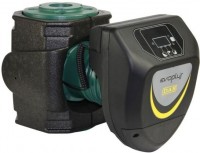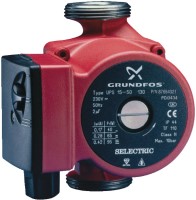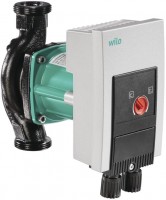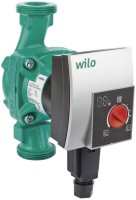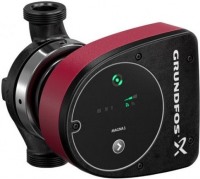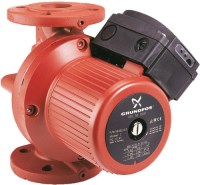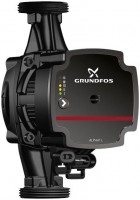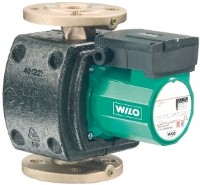Circulation Pumps Grundfos
All models Advanced filters → |
You might be interested in
Circulation Pumps: specifications, types
Main function
The main application for which the pump is designed.
— Central heating. By the name, pumps are designed to circulate the heating medium in the heating system. It avoids stagnation and ensures the efficiency and uniformity of heat transfer; without a pump, the circulation intensity would be insufficient due to the high hydro-resistance of the system. A mandatory feature of units for this purpose is the ability to operate at a high temperature of the p...umped liquid (see below) — about 95 °C, or even more. Note that this allows the use of such pumps also in cold and hot water supply systems (see below); however, this can hardly be called the best option — models for heating usually cost more than other types due to high heat resistance and performance, and these are redundant in the DHW circuits.
— DHW recirculation. Pumps whose task is to move water along the domestic hot water circuit. Such units are used in autonomous hot water systems — in other words, houses and apartments with their own water heaters. Constant circulation ensures uniform distribution of water throughout the circuit; in fact, this means that after opening the corresponding tap, you do not have to wait until hot water reaches the point of disassembly from the heater — it will immediately be hot. Like the central heating pumps (see above), DHW pumps can work with high-temperature water; however, for most models, the maximum temperature (see below) is 60 – 65 °C; therefore, such a unit cannot be installed in the heating system. At the same time, some exceptions can withstand up to 95 °C — they differ quite conditionally from heating pumps, mainly due to lower performance (usually less than 600 – 700 L/h). With cold water, models for this purpose usually cope without problems.
— TCold water pressure boost. Pumps are designed to provide additional pressure in the cold water circuit — for example, if the pressure in the water supply drops or if the main pump supplying the system with water does not reach the required pressure. The key difference of this type from the others described above is the low operating temperature (maximum — less than 60 °C) and, accordingly, the impossibility of working with hot water.
Many models allow use in other areas than those described above — for example, models for DHW recirculation may be suitable for operation in air conditioning or refrigeration systems.
— Central heating. By the name, pumps are designed to circulate the heating medium in the heating system. It avoids stagnation and ensures the efficiency and uniformity of heat transfer; without a pump, the circulation intensity would be insufficient due to the high hydro-resistance of the system. A mandatory feature of units for this purpose is the ability to operate at a high temperature of the p...umped liquid (see below) — about 95 °C, or even more. Note that this allows the use of such pumps also in cold and hot water supply systems (see below); however, this can hardly be called the best option — models for heating usually cost more than other types due to high heat resistance and performance, and these are redundant in the DHW circuits.
— DHW recirculation. Pumps whose task is to move water along the domestic hot water circuit. Such units are used in autonomous hot water systems — in other words, houses and apartments with their own water heaters. Constant circulation ensures uniform distribution of water throughout the circuit; in fact, this means that after opening the corresponding tap, you do not have to wait until hot water reaches the point of disassembly from the heater — it will immediately be hot. Like the central heating pumps (see above), DHW pumps can work with high-temperature water; however, for most models, the maximum temperature (see below) is 60 – 65 °C; therefore, such a unit cannot be installed in the heating system. At the same time, some exceptions can withstand up to 95 °C — they differ quite conditionally from heating pumps, mainly due to lower performance (usually less than 600 – 700 L/h). With cold water, models for this purpose usually cope without problems.
— TCold water pressure boost. Pumps are designed to provide additional pressure in the cold water circuit — for example, if the pressure in the water supply drops or if the main pump supplying the system with water does not reach the required pressure. The key difference of this type from the others described above is the low operating temperature (maximum — less than 60 °C) and, accordingly, the impossibility of working with hot water.
Many models allow use in other areas than those described above — for example, models for DHW recirculation may be suitable for operation in air conditioning or refrigeration systems.
Design
— Single head. The classical design provides one chamber with a working wheel. Among these pumps, there are models of almost any power and performance. Other things being equal, single pumps are cheaper than twin-head pumps. However they have a higher probability of failure, but in most cases, this is not of decisive importance, and the overall reliability is quite sufficient for both domestic and many professional tasks.
— Twin head. Twin models are...equipped with two impellers; in fact, such a unit consists of two pumps connected in parallel. It provides an increased degree of reliability compared to single designs: the twin-head pump continues to work even with a complete failure of one half (although the performance, of course, is reduced). In addition, it is easier to ensure good performance — as a result, even the most modest units of this type are capable of delivering about 6-7 thousand litres per hour. The reverse side of these advantages is the complexity of the design and, accordingly, the high cost; therefore, it is worth paying attention to such models in the case when high reliability and maintaining performance in case of malfunctions are critical for you.
— Twin head. Twin models are...equipped with two impellers; in fact, such a unit consists of two pumps connected in parallel. It provides an increased degree of reliability compared to single designs: the twin-head pump continues to work even with a complete failure of one half (although the performance, of course, is reduced). In addition, it is easier to ensure good performance — as a result, even the most modest units of this type are capable of delivering about 6-7 thousand litres per hour. The reverse side of these advantages is the complexity of the design and, accordingly, the high cost; therefore, it is worth paying attention to such models in the case when high reliability and maintaining performance in case of malfunctions are critical for you.
Pump type
— Centrifugal. As the name suggests, this type of pump uses centrifugal force. Their main element is the impeller installed in a round casing; the inlet is located on the axis of rotation of this wheel. During operation, due to the centrifugal force that occurs during the rotation of the wheel, the liquid is thrown from the centre to its edges and then enters the outlet pipe directed tangentially to the circle of rotation of the wheel. Centrifugal pumps are quit...e simple in design and inexpensive, while they are reliable and economical (due to high efficiency), and the fluid flow is continuous. At the same time, the performance of such units can drop with high resistance in the circuit.
— Vortex. Vortex pumps are somewhat similar to centrifugal pumps: they also have a round casing and an impeller with blades. However, in such units, the inlet and outlet pipes of the working chamber are directed tangentially to the wheel, and the blades differ in design. The method of operation is also fundamentally different — it uses the vortices formed on the wheel blades. Vortex units are significantly superior to centrifugal units in terms of pressure, but they are sensitive to contamination — even small particles entering the impeller can cause damage, significantly reducing efficiency. And the efficiency of vortex pumps is low — 2-3 times lower than that of centrifugal pumps.
— Vortex. Vortex pumps are somewhat similar to centrifugal pumps: they also have a round casing and an impeller with blades. However, in such units, the inlet and outlet pipes of the working chamber are directed tangentially to the wheel, and the blades differ in design. The method of operation is also fundamentally different — it uses the vortices formed on the wheel blades. Vortex units are significantly superior to centrifugal units in terms of pressure, but they are sensitive to contamination — even small particles entering the impeller can cause damage, significantly reducing efficiency. And the efficiency of vortex pumps is low — 2-3 times lower than that of centrifugal pumps.
Rotor type
The type of rotor the pump is equipped with.
— Wet. "Wet refers to rotors that are in direct contact with the pumped liquid. It achieves several advantages. The liquid provides lubrication and cooling of the rotor — which increases reliability, allowing the pump to work for a long time without additional maintenance, and reduces the noise level. The latter is especially important for residential premises, which is why they use wet rotor pumps. In add...ition, the units themselves are simple (in design and repair), compact and inexpensive. Their main disadvantage is a lower efficiency than in "dry" models — usually up to 50%. It is not critical for domestic use, but wet rotors are poorly suited for high-performance professional models.
— Dry. The name of such a rotor is because it does not come into contact with the pumped liquid. The key advantage of this design over the "wet" one is high efficiency — about 80%. On the other hand, dry rotors produce more noise and are not suitable for residential applications. Therefore, this option is typical mainly for high-performance units designed for industrial use.
— Wet. "Wet refers to rotors that are in direct contact with the pumped liquid. It achieves several advantages. The liquid provides lubrication and cooling of the rotor — which increases reliability, allowing the pump to work for a long time without additional maintenance, and reduces the noise level. The latter is especially important for residential premises, which is why they use wet rotor pumps. In add...ition, the units themselves are simple (in design and repair), compact and inexpensive. Their main disadvantage is a lower efficiency than in "dry" models — usually up to 50%. It is not critical for domestic use, but wet rotors are poorly suited for high-performance professional models.
— Dry. The name of such a rotor is because it does not come into contact with the pumped liquid. The key advantage of this design over the "wet" one is high efficiency — about 80%. On the other hand, dry rotors produce more noise and are not suitable for residential applications. Therefore, this option is typical mainly for high-performance units designed for industrial use.
Max. flow
The maximum flow of a pump is the amount of liquid it can pump in a certain amount of time.
Features of choosing the optimal performance option depend primarily on the purpose of the pump (see above). For example, for DHW recirculation models, the pump performance should not exceed the performance of the water heater. If the water heater is capable of delivering 10 litres per minute to the DHW circuit, then the maximum pump performance will be 10*60=600 L/h. The basic formula for cal...culating the performance of a heating system takes into account the power of the heater and the temperature difference at the inlet and outlet, and for the cold water system — the number of points of water intake. More detailed information about the calculations for each application can be found in special sources, and it is better to entrust the calculations themselves to professionals.
Features of choosing the optimal performance option depend primarily on the purpose of the pump (see above). For example, for DHW recirculation models, the pump performance should not exceed the performance of the water heater. If the water heater is capable of delivering 10 litres per minute to the DHW circuit, then the maximum pump performance will be 10*60=600 L/h. The basic formula for cal...culating the performance of a heating system takes into account the power of the heater and the temperature difference at the inlet and outlet, and for the cold water system — the number of points of water intake. More detailed information about the calculations for each application can be found in special sources, and it is better to entrust the calculations themselves to professionals.
Max. head
The head can be described as the maximum height to which a pump can lift liquid through a vertical pipe without bending or branching. This parameter is directly related to the pressure that the pump produces: 10 m of head approximately corresponds to a pressure of 1 bar (do not confuse this parameter with operating pressure — see more about it below).
The head is one of the key specs for most circulation pumps. Traditionally, it is calculated based on the difference in height between...the location of the pump and the highest point of the system; however, this principle is relevant only for units that boost the pressure of cold water(see "Suitable for"). Circulation pumps for heating and DHW work with closed circuits, and the optimal pressure depends on the total hydraulic resistance of the system. Detailed calculation formulas for the first and second cases can be found in special sources.
The head is one of the key specs for most circulation pumps. Traditionally, it is calculated based on the difference in height between...the location of the pump and the highest point of the system; however, this principle is relevant only for units that boost the pressure of cold water(see "Suitable for"). Circulation pumps for heating and DHW work with closed circuits, and the optimal pressure depends on the total hydraulic resistance of the system. Detailed calculation formulas for the first and second cases can be found in special sources.

